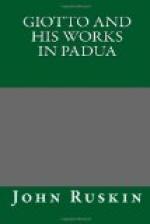[Footnote 3: Lord Lindsay, Christian Art, vol. ii. p. 166.]
[Footnote 4: At Pietra Mala. The flames rise two or three feet above the stony ground out of which they spring, white and fierce enough to be visible in the intense rays even of the morning sun.]
We may fancy the glance of the boy, when he and Cimabue stood side by side on the ridge of Fiesole, and for the first time he saw the flowering thickets of the Val d’Arno; and deep beneath, the innumerable towers of the City of the Lily, the depths of his own heart yet hiding the fairest of them all. Another ten years passed over him, and he was chosen from among the painters of Italy to decorate the Vatican.
The account given us by Vasari of the mode of his competition on this occasion, is one of the few anecdotes of him which seem to be authentic (especially as having given rise to an Italian proverb), and it has also great point and value. I translate Vasari’s words literally.
“This work (his paintings in the Campo Santo of Pisa) acquired for him, both in the city and externally, so much fame, that the Pope, Benedict IX., sent a certain one of his courtiers into Tuscany, to see what sort of a man Giotto was, and what was the quality of his works, he (the pope) intending to have some paintings executed in St. Peter’s; which courtier, coming to see Giotto, and hearing that there were other masters in Florence who excelled in painting and in mosaic, spoke, in Siena, to many masters; then, having received drawings from them, he came to Florence; and having gone one morning into Giotto’s shop as he was at work, explained the pope’s mind to him, and in what way he wished to avail himself of his powers, and finally requested from him a little piece of drawing to send to his Holiness. Giotto, who was most courteous, took a leaf (of vellum?), and upon this, with a brush dipped in red, fixing his arm to his side, to make it as the limb of a pair of compasses, and turning his hand, made a circle so perfect in measure and outline, that it was a wonder to see: which having done, he said to the courtier, with a smile, ’There is the drawing.’ He, thinking himself mocked, said, ’Shall I have no other drawing than this?’ ‘This is enough, and too much,’ answered Giotto; ‘send it with the others: you will see if it will be understood.’ The ambassador, seeing that he could not get any thing else, took his leave with small satisfaction, doubting whether he had not been




